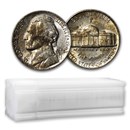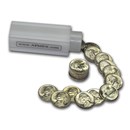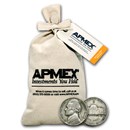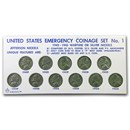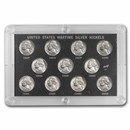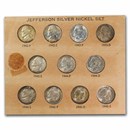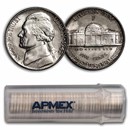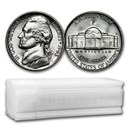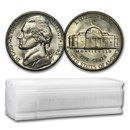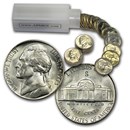35% Silver War Nickels
About 35% Silver War Nickels
"Silver War Nickels" refers to a specific type of United States five-cent coin, also known as a nickel, produced during World War II. From 1942 to 1945, nickel composition was changed due to the need for nickel in the war effort.The Silver War Nickels comprised 56% copper, 35% silver, and 9% manganese. This alteration was made to conserve nickel, a vital metal used in producing armor, artillery, and other military equipment. The reduced nickel content was replaced with silver and manganese, which were more readily available.
These wartime nickels are distinguishable from regular nickels by their significant mint mark above Monticello, the image of Thomas Jefferson's home on the reverse side of the coin. The mint mark "P" (for Philadelphia), "D" (for Denver), or "S" (for San Francisco) can be found above the dome of Monticello.
The Silver War Nickels were slightly larger and heavier than the regular nickels minted before and after the war. They weigh 5 grams instead of the usual 5.67 grams and have a diameter of 21.2 mm compared to the standard 21.21 mm.
It's worth noting that the silver content of these nickels is significant and can have a higher intrinsic value than their face value. However, their numismatic value to collectors depends on factors such as condition, rarity, and demand. Investors in search of silver coins that have a more straightforward metal content, like 99.9% silver, may want to consider our selection of American Silver Eagles instead.
Why Silver Content Was Restricted
During World War II, the United States reduced the silver content in its coins, including the Silver War Nickels, due to the increased demand for metals required for the war effort. There were several reasons behind this decision:- Conservation of strategic metals: The war effort required significant amounts of metals like nickel, copper, and silver for various military purposes. These metals were vital for producing weapons, ammunition, and other military equipment. By reducing the silver content in coins, the government aimed to conserve these strategic metals and allocate them to more critical wartime uses.
- Increased industrial demand: The production of war materials and equipment required significant metal resources. Nickel, in particular, was needed for manufacturing armor plates, artillery shells, and other military machinery. By reducing the nickel content in coins, the government could redirect the available supply to meet the growing industrial demand.
- Cost considerations: The reduced silver content in coins helped control costs during the war. Silver is a precious metal, and its high value made it expensive to mint coins with a full silver range. By reducing the silver content, the government could save on material costs and allocate resources more efficiently.
- International trade concerns: During the war, the United States aimed to maintain strong relationships with its allies and secure access to necessary resources. Exporting silver to help fund the war efforts of allies, such as the United Kingdom, became crucial. By reducing the silver content in coins, the United States could free up more silver for international trade.
Collecting Historical Nickels From the U.S. Mint
Numismatists and collectors alike enjoy Wartime Jefferson nickels for their historical value, short issuance, and unique composition among U.S. coins. They add timeless value and silver weight to any coin collection. Another historical series worth considering is the Buffalo nickel series, which was produced directly before the Jefferson nickel and issued for a brief 20 years.Check out what other customers are saying.



